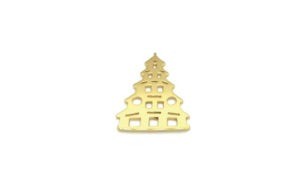 The Chinese Tower is a pagoda located in the 375-hectare English Garden in Munich. It is made of wood, is 25 metres high and has five floors, which become narrower towards the top. The individual storeys are decorated with shingle-covered roofs and golden metal spheres. Inside, a spiral staircase leads to the top. The Chinese Tower is the landmark of the English Garden and a symbol of Munich.
The Chinese Tower is a pagoda located in the 375-hectare English Garden in Munich. It is made of wood, is 25 metres high and has five floors, which become narrower towards the top. The individual storeys are decorated with shingle-covered roofs and golden metal spheres. Inside, a spiral staircase leads to the top. The Chinese Tower is the landmark of the English Garden and a symbol of Munich.
Chinese tower was a viewpoint
The tower was built in 1789/90 according to a design by architect Joseph Frey. This was inspired by the Chinese pagoda in London's Kew Gardens, which was built from bricks in 1762. From 1792, the Chinese Tower and the English Garden, which was previously used by the Wittelsbach ruling family as a hunting ground, were open to the public. The tower served as a viewing platform, as the trees were not very tall at the time.
Since the 1970s, however, for safety reasons, only the brass band, which plays there several times a week in summer, has been allowed to enter. The China Tower has burned down from time to time - most recently in 1944 when it was hit by an aerial bomb. It was rebuilt in 1952.
Dancing at sunrise in the Munich beer garden
Once a year, one of Munich's most beautiful events takes place there - the so-called Kocherlball. This festival originated in 1880, when Munich's servants met here to dance on Sundays before work began. At the beginning of the 20th century, the city leaders abolished the event as they felt it was too immoral.
It was not until 1989 that the old tradition was revived. Since then, around 10,000 Munich residents have come together to dance on the third Sunday in July at 6 (!) in the morning, either in traditional Bavarian costume or dressed in the style of the former servants.
There was already a pub serving beer inside and outside at the Chinaturm in the Biedermeier period. Munich's second largest beer garden has been located there since 1974. Right next to the Chinese Tower there is also a nostalgic children's carousel with beautiful wood-carved Biedermeier figures from 1913.